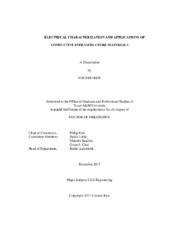| dc.description.abstract | The feasibility of multifunctional applications of electrically conductive asphalt concrete is investigated. The conductive asphalt concrete has a huge potential for various multifunctional applications such as self-healing, self-sensing, and deicing. This study examines the method of controlling conductivity of asphalt composites, electrical characterization of the composites with alternating current impedance spectroscopy (ACIS), application for damage self-sensing, and application for removing snow and ice on pavements.
Aiming to control the electrical conductivity of asphalt concrete with a smooth transition from insulated to conductive phase, nine types of graphite having different particle shape, size, and origin were mixed with asphalt binders, and their effects on imparting conductivity were investigated. The natural flake graphite is effective to mitigate the percolation threshold, and a sufficiently high conductivity (up to 10^2 Ω·cm) can be achieved by replacing a part of fillers only with the graphite.
For the electrical characterization of the conductive asphalt composites, ACIS is employed. Through this technique, the equivalent electrical circuits in various levels of conductivity is constructed for the first time. The results show that a specific conductivity range containing 20-25% flake graphite by weight of the asphalt mastic is suitable for sensing applications.
Self-sensing of damage is one of probable multifunctional applications of the conductive asphalt concrete, and its feasibility is investigated using ACIS. The experiments with dry and wet conditions show that the real and imaginary impedance increase with the increase of the damage, while the capacitance value does not show a clear relationship with the damage evolution. The results also show that the distance between electrodes is important for measuring damage with ACIS.
The feasibility of the heated pavement using the conductive asphalt as a cost-effective and pollution-free solution was investigated. Bench scale slab heating test, non-steady state heat transfer analysis, and life-cycle assessment (LCA) were conducted. The results of these methodologies reveal that the heating capacity of the conductive asphalt is sufficient for deicing on pavement surfaces.
The electrical and mechanical data obtained from this study provide essential information on multifunctional applications of conductive asphalt concrete, which will lead to technical innovations for more sustainable pavement systems. | en |


